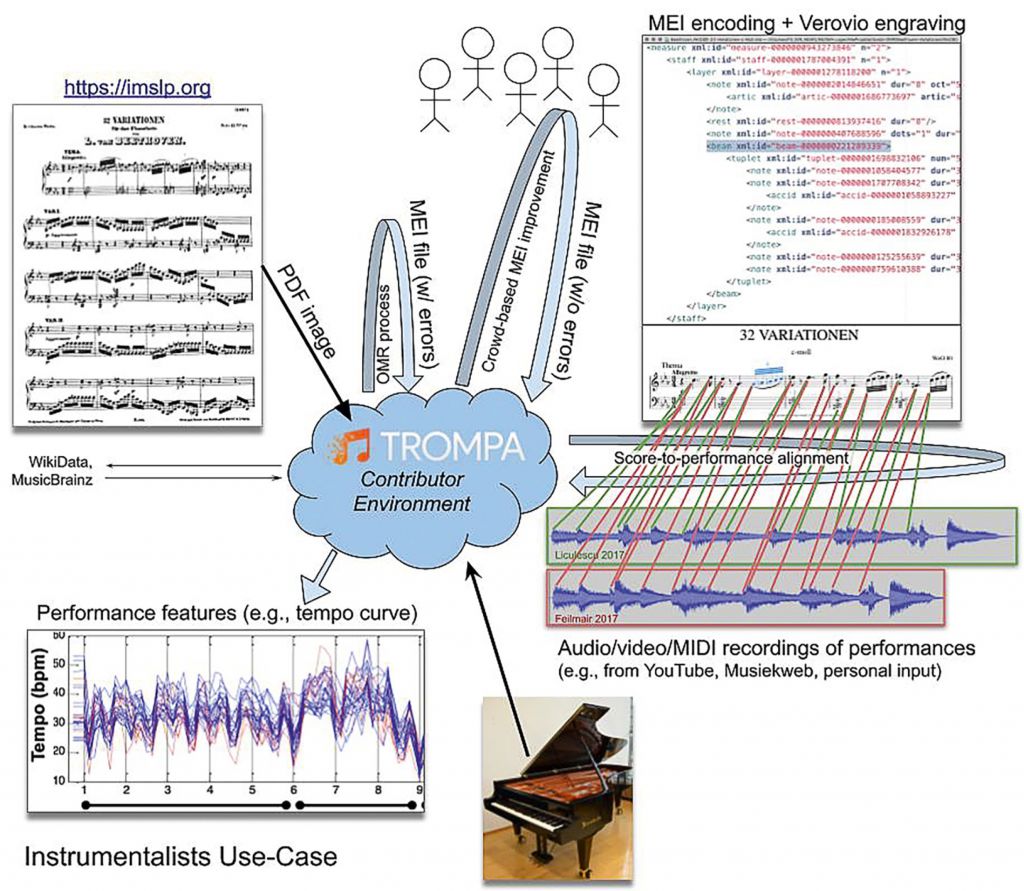The European Commission-funded research and innovation action TROMPA – Towards Richer Online Music Public-domain Archives1 aims to create a digital platform on which all of us can help shape the digitisation, interconnection, and enrichment of all manifestations of “classical music”, including scores and sound recordings.
Classical music represents treasured cultural heritage and contemporary tradition, perpetuated and re-interpreted through practice, performance, scholarship, and listening enjoyment. Classical music is widely available on the Web in numerous forms. Music libraries and archives (such as IMSLP2 or the British Library’s collection of music3) provide public access to digitised images of printed and handwritten musical scores and other source documents. Online platforms such as YouTube and Spotify provide access to audio-visual recordings of classical music along with the relevant metadata (e.g., title, performer, composer). At present, however, these platforms are only sparsely interconnected—providing only limited opportunities for user interaction beyond mere consumption.
TROMPA makes use of cutting-edge music information retrieval (MIR) techniques to generate publicly licensed digital music encodings of our musical heritage (in the scholarly MEI format4) and incorporates crowd feedback in order to progressively improve them. These encodings are interlinked and synchronised with multimodal digital materials (e.g. to produce score-to-performance alignment of musical notation and recordings) and enriched with human insight through crowd annotations (Figure 1), providing a framework for diverse web applications that enable users to interact with the resulting web of interconnected music data.
The Contributor Environment orchestrates data, sources, and processes
The Contributor Environment (CE) forms the central hub of TROMPA’s data infrastructure. It aggregates references to externally hosted media content (recordings, scores, etc), stores metadata relating to musical works and performance recordings interlinked with other public domain repositories such as Wikidata or MusicBrainz, and coordinates the execution of automated processes such as optical music recognition (OMR) and score-to-performance alignment. The CE does not store the media content itself, but instead uses URLs to reference Web-accessible resources stored in external repositories. It thus provides a unified means of querying and managing such content across collections. The data is organised according to Web 3.0 standards (Linked Data, Semantic Web) and adheres to the FAIR principles, which require data to be findable, accessible, interoperable, and reusable. Wherever possible, information within the CE is available as Open Data, specifically licensed for public access and re-use (with consent granted by the participating musicians).
Five user groups, five use cases
TROMPA targets five user groups—instrumentalists, music scholars, orchestras, choirs, and music enthusiasts—and develops use cases around the music information requirements of each group. Each use case involves accessing the central CE component via purpose-developed web applications.
A performance companion for piano players
The Department of Music Acoustics – Wiener Klangstil (IWK) is currently developing a Performance Companion as part of the “instrumentalists” use case that is intended to provide soloists and ensemble players with digital assistance in their daily practising and rehearsing. For instance: a pianist is practicing a new piece (say, Beethoven’s Appassionata). She selects a score on her tablet computer; if it’s not yet available in the CE in digital form, she can upload a public domain score image that the CE will convert into MEI format, following which she can quickly make a cursory pass over the file to fix conversion errors. She leaves any remaining minor issues for correction later on by the crowd. As she practices, her performance is streamed (as audio or symbolic data) to an alignment process coordinated by the CE, which generates metadata to synchronise her performance timeline with the digital score. After she’s finished playing her rehearsal rendition, a note-level tempo curve visualisation is immediately available for her inspection. She can now compare her tempo curves with those extracted from her favourite recording of the piece on YouTube or Spotify, say by Claudio Arrau. While listening to Arrau’s performance, she jots down a personal note about a particular section of the Appassionata. Her comment is documented and stored within the CE as a Web Annotation5 that targets both the relevant section of the digital score and the corresponding timespan of Arrau’s performance. A scholar analysing this section in the course of an investigation of Beethoven’s piano sonatas can then discover and retrieve her annotation alongside those authored by other pianists, incorporate them into his analysis, and reference them within a scholarly publication.
The TROMPA Consortium is comprised of four academic institutions (including partners from Delft, Barcelona, and London alongside our own department in Vienna), three small- and medium-sized start-up enterprises, and two “content owner” institutions—Muziekweb (Rotterdam) and the Royal Concertgebouw Orchestra (Amsterdam). TROMPA is currently completing its first year of activity, with the use case components largely implemented in prototypical form. The project will conclude in mid-2021. To attain the scalability required for the project to be truly useful to our selected user groups, the technical challenges are joined by the task of building a large community of enthusiastic music lovers of diverse musical backgrounds and levels of expertise to work together on the creation of a comprehensive, widely interlinked and richly annotated archive of publicly licensed score encodings on the Web. We’d therefore like to warmly invite you to participate in this effort to digitise and enrich our musical heritage in the near future. For more information on how to join in, please have a look at trompamusic.eu.


